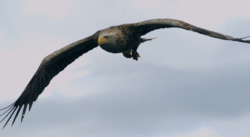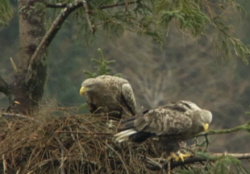The Power of the Atlantic Ocean
Fertile Tiree
Hebrides: Islands on the Edge - Ewan McGregor

The inner Hebrides’ islands of Mull, Coll and Tiree are truly islands on the edge. They are fully exposed to the power of the Atlantic Ocean.
It’s late winter and the Lords of the Isles are searching for food. Everywhere the eagles fly, animals are doing whatever it takes to survive. Summoning the last of their strength, holding out for spring.
In any year, their lives are hard, but once in a generation when the spring reaches these islands it proves even more testing than the winter.
And then it will be the power of the sea that makes the difference between life and death. But, despite their immense size and strength, even the eagles will have to work hard to survive until then.
Here on the Isle of Mull, where this Eagle and his mate live, scavengers have gathered hoping something edible has been washed ashore and he wants to know what they’ve found; it’s just a shell.
For 60 years, white-tailed eagles have been gone from these islands exterminated by people but, since the 1970s they’ve been reintroduced. The gulls haven’t missed them, they’re old enemies. But, since the white-tailed eagles came back to Mull they have ruled this space and they make sure they get the best of whatever washes up.
Later, in the spring, this pair will need all the strength and skill they can muster when they start a family.
Close by, on the mainland the sea cuts deep into the coast narrow lochs lined with woods. Leafless and quiet for now. There is little food but red squirrels have made provisions for winter. They bring a dash of colour and life to the woods. Collecting the last of the nuts they laid away in autumn. But, as the light fades, they pause, these woods are not safe after dark.
It’s going to be a windy night and as the light has ebbed away so the tide falls. A deer leaves the safety of the trees and an enterprising pine marten comes to search the shore. On a calmer night she’d be hunting for squirrels or birds in the treetops. A young marten has joined its mother; her kit from last year. It’s old enough to go it alone, if it can just get through this storm, perhaps the last one of the winter.
Beside the pine marten’s coastal woods a river runs down to the sea. Here, at last, Scotland’s West Coast shows its milder face.
A short-eared owl, unusually for an owl he’s not shy of the daylight in fact, he’s relishing the warmth of the sun and hidden in the heather his mate has started to lay her eggs. For the next month she’ll scarcely leave the nest and he will feed the entire family.
The eagles lives have moved on too. Their home on the Isle of Mull is an ideal blend of coast, open hill and mountain. No wonder that almost a third of all Scotland’s white tailed eagles live here. And conifer plantations by the sea are among their favourite places to nest.

It takes real skill to build such a large nest, and some are better at it than others. It’s time for the female to take over but first, she needs to find yet another stick. There isn’t really room for both of them at once. Not much is certain in the Hebrides even for such powerful birds, raising young here is hard. But, with luck they’ll soon become parents.
In the oak forests of the West Coast Spring has come and the trees are being transformed. In a cottage in the woods a female pine marten has found a safe place to sleep. All around her, the trees are filling with life. The oaks draw on their reserves turning stored energy into new leaves. It’s the start of an easier time for everyone. She can afford to dream and, if she’s pregnant this attic could soon become a den for a new family.
The forest is full of song. This male redstart weighs no more than an airmail letter. But, he’s just flown 6,000 km from a tropical forest in Africa. He’s come because all these new leaves are feeding a host of insects. But on this coast spring and the food supply can be fickle. He must find a hole to nest in as fast as he can. But, low down in this alder tree he’s found a perfect place and there’s a female. She looks interested. A quick look around and she approves.
On land the pace of spring is unstoppable but, in the sea alongside it’s a different story. The fallen tree which so nearly killed the martens now has fish in its branches. There is no spring warmth in this oak. The sea is colder now than it was when it fell but, some are preparing for spring.
Animals fixed to rocks have a real problem. How can they spread? But, these minute polyps have a unique solution. Each transforms itself, casting off minute, brand to new moon jellyfish just 2 mm across. They’re starting a dangerous journey, travelling down their quiet loch towards the open sea, where they have an appointment with the spring.
Far offshore from the sea loch and its woods lies the Isles of Coll and Tiree. Coll is rocky and hard to farm. But, Tiree is an island built of sand famous for being fertile. People have farmed here for thousands of years. Even its name, means land of corn.
And there are wild animals here who’re famously fertile too. And their fortunes depend on the sea. Most of these hares are females looking for a mate. But, female hares are fussy. She wants the best father for her young and she’s prepared to wait for Mr Right. She joins the group to test the boys and off they go, several males in hot pursuit. Now she’ll judge their speed and how they deal with her other suitors. She doubles back and leads them on a merry dance. Some of the males fall behind. But, this one has found her scent. And, then she is taking a rest while the others chase their own tails. They’ve lost her completely.
But, she’s not quite ready for him. He still has one rival left. That’s him dealt with. And at last, she’s not running away. But, she’s scent marking again to attract more males. Talk about playing hard to get! It must be frustrating sometimes being a male hare. But, if you are, Tiree is a great place to live. And the hares owe much of their comfort to this. The remains of countless shells ground by the sea into Tiree’s pale sands and blown inland, they fertilise the island’s fields. And, the sea around these islands is unusually fertile too. But, in bad weather these are dangerous waters.
